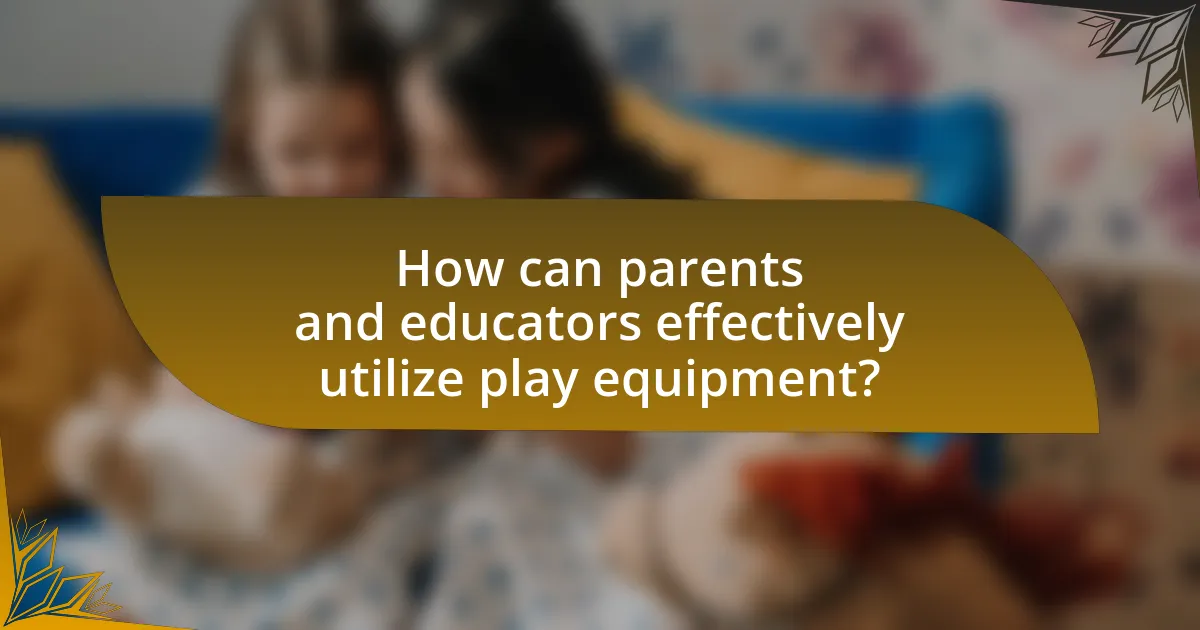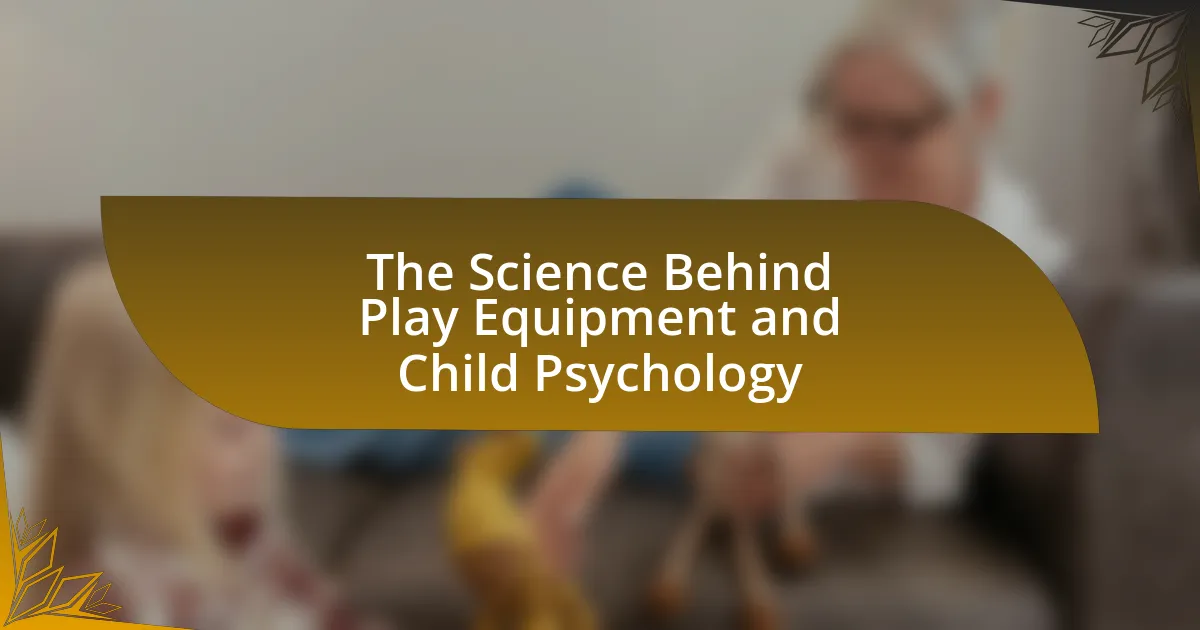The article explores the science behind play equipment and its impact on child psychology, emphasizing the critical role of play in cognitive, social, and emotional development. It highlights how various types of play equipment, such as climbing structures, swings, and interactive panels, contribute to physical health, problem-solving skills, and social interactions among children. The discussion includes the importance of age-appropriate design, safety considerations, and the psychological theories that underpin the benefits of play. Additionally, it addresses how parents and educators can effectively utilize play equipment to enhance learning outcomes and support holistic child development.

What is the Science Behind Play Equipment and Child Psychology?
The science behind play equipment and child psychology reveals that play is essential for cognitive, social, and emotional development in children. Research indicates that engaging with play equipment fosters creativity, problem-solving skills, and physical coordination. For instance, a study published in the journal “Child Development” by researchers from the University of Illinois found that children who regularly use playgrounds exhibit improved social skills and increased physical activity levels. This interaction with play equipment not only enhances motor skills but also promotes social interactions, allowing children to learn cooperation and conflict resolution. Thus, the design and availability of play equipment significantly influence child development outcomes.
How does play equipment influence child development?
Play equipment significantly influences child development by promoting physical, cognitive, and social skills. Engaging with various types of play equipment, such as swings, slides, and climbing structures, encourages children to develop gross motor skills, enhance coordination, and improve balance. Research indicates that active play contributes to physical health, with studies showing that children who engage in regular physical activity are less likely to experience obesity and related health issues.
Cognitively, play equipment stimulates problem-solving and critical thinking as children navigate challenges and explore their environment. For instance, climbing structures require children to assess risks and make decisions, fostering cognitive development. Socially, play equipment serves as a platform for interaction, allowing children to learn cooperation, negotiation, and conflict resolution skills through group play. A study published in the Journal of Play and Development highlights that children who engage in cooperative play on equipment develop better social skills and emotional regulation.
Overall, play equipment is essential for holistic child development, providing opportunities for physical activity, cognitive challenges, and social interaction.
What types of play equipment are most beneficial for children?
The types of play equipment most beneficial for children include climbing structures, swings, slides, and interactive play panels. Climbing structures promote physical strength, coordination, and problem-solving skills, while swings enhance balance and spatial awareness. Slides provide opportunities for risk assessment and thrill-seeking, which are important for emotional development. Interactive play panels stimulate cognitive skills through imaginative play and social interaction. Research indicates that diverse play equipment supports holistic development, as outlined in the study “The Importance of Play in Promoting Healthy Child Development and Maintaining Strong Parent-Child Bonds” by Kenneth R. Ginsburg, published in Pediatrics.
How does play equipment cater to different developmental stages?
Play equipment caters to different developmental stages by providing age-appropriate challenges that promote physical, cognitive, and social skills. For infants, soft play mats and sensory toys encourage exploration and motor skill development. Toddlers benefit from climbing structures and balance beams that enhance gross motor skills and coordination. Preschoolers engage with interactive playsets that foster imaginative play and social interaction, while school-age children utilize more complex equipment, such as obstacle courses, that challenge their problem-solving abilities and teamwork. Research indicates that play equipment designed for specific age groups supports developmental milestones, as outlined in the American Academy of Pediatrics guidelines, which emphasize the importance of play in child development.
Why is understanding child psychology important in designing play equipment?
Understanding child psychology is crucial in designing play equipment because it ensures that the equipment meets the developmental needs and preferences of children. By incorporating principles of child psychology, designers can create play structures that promote cognitive, social, and physical development. For instance, research indicates that children engage more effectively with play equipment that aligns with their developmental stages, such as providing opportunities for imaginative play and physical challenges appropriate for their age group. This alignment enhances children’s learning experiences and encourages healthy social interactions, as supported by studies like those conducted by the American Academy of Pediatrics, which emphasize the importance of play in child development.
What psychological theories relate to play and learning?
Psychological theories that relate to play and learning include Piaget’s Theory of Cognitive Development, Vygotsky’s Social Development Theory, and the Constructivist Theory. Piaget’s theory posits that children learn through play by actively engaging with their environment, which fosters cognitive development through stages. Vygotsky emphasizes the social aspect of learning, suggesting that play facilitates social interaction and cultural understanding, which are crucial for cognitive growth. Constructivist Theory further supports the idea that children construct knowledge through experiences, including play, allowing them to explore, experiment, and learn in a hands-on manner. These theories collectively highlight the integral role of play in enhancing learning and cognitive development in children.
How do children’s emotional needs shape their interaction with play equipment?
Children’s emotional needs significantly influence their interaction with play equipment by determining their level of engagement, exploration, and risk-taking. When children feel secure and supported emotionally, they are more likely to explore play equipment confidently, which fosters creativity and social interaction. Conversely, if children experience anxiety or fear, they may avoid certain equipment or engage less, limiting their developmental opportunities. Research indicates that emotionally supportive environments enhance children’s willingness to engage in play, as seen in studies showing that children in nurturing settings exhibit more adventurous play behaviors and social interactions.
What role does play have in a child’s cognitive and social development?
Play is essential for a child’s cognitive and social development as it fosters critical thinking, problem-solving skills, and social interaction. Engaging in play allows children to explore their environment, experiment with ideas, and develop language skills through communication with peers. Research indicates that play enhances brain development; for instance, a study published in the journal “Child Development” by researchers from the University of California found that children who engage in imaginative play demonstrate improved cognitive flexibility and social competence. Additionally, play provides opportunities for children to learn cooperation, negotiation, and conflict resolution, which are vital social skills.
How does play promote problem-solving skills in children?
Play promotes problem-solving skills in children by providing opportunities for exploration, experimentation, and critical thinking. During play, children encounter challenges that require them to devise strategies, make decisions, and adapt their approaches based on outcomes. Research indicates that unstructured play, such as building with blocks or engaging in role-playing, enhances cognitive flexibility and creativity, which are essential components of effective problem-solving. For instance, a study published in the journal “Child Development” by researchers from the University of California found that children who engaged in imaginative play demonstrated improved problem-solving abilities in subsequent tasks compared to those who did not participate in such activities. This evidence underscores the significant role of play in developing essential cognitive skills in children.
What social skills are developed through interactive play equipment?
Interactive play equipment fosters several essential social skills, including communication, cooperation, and conflict resolution. Through engaging with peers in a shared play environment, children learn to express their thoughts and feelings, negotiate roles, and collaborate on tasks. Research indicates that children who participate in interactive play are more likely to develop empathy and understand social cues, as they navigate various social interactions. For instance, a study published in the Journal of Play Therapy highlights that children who engage in cooperative play demonstrate improved social competence and emotional regulation, reinforcing the importance of interactive play equipment in developing these critical social skills.
How can we measure the impact of play equipment on child psychology?
The impact of play equipment on child psychology can be measured through observational studies, psychological assessments, and behavioral analysis. Observational studies can track children’s interactions with various types of play equipment, noting changes in behavior, social skills, and emotional responses. Psychological assessments, such as standardized tests, can evaluate cognitive and emotional development before and after exposure to specific play equipment. Behavioral analysis can involve monitoring play patterns, problem-solving abilities, and social interactions, providing quantitative data on how different equipment influences psychological outcomes. Research has shown that active play, facilitated by appropriate equipment, enhances cognitive development and emotional well-being in children, as evidenced by studies like those conducted by Pellegrini and Smith (1998) in “The Development of Play.”
What are the key factors to consider when selecting play equipment?
The key factors to consider when selecting play equipment include safety, age appropriateness, durability, and developmental benefits. Safety is paramount; equipment should meet safety standards to minimize injury risks, such as having rounded edges and non-toxic materials. Age appropriateness ensures that the equipment is suitable for the child’s developmental stage, promoting engagement without frustration or danger. Durability is essential for long-term use, as high-quality materials withstand wear and tear, reducing replacement costs. Lastly, developmental benefits should be considered; equipment that encourages physical, social, and cognitive skills supports holistic child development, as evidenced by studies showing that active play enhances motor skills and social interactions.

What are the different types of play equipment and their psychological benefits?
Different types of play equipment include swings, slides, climbing structures, and interactive play panels, each offering unique psychological benefits. Swings promote relaxation and sensory integration, helping children develop balance and coordination while providing a calming effect. Slides encourage risk-taking and confidence as children learn to navigate heights and speeds, fostering a sense of achievement. Climbing structures enhance problem-solving skills and physical strength, as they require children to assess their abilities and make decisions about their movements. Interactive play panels stimulate cognitive development through imaginative play and social interaction, promoting communication skills and teamwork. Research indicates that engaging with diverse play equipment supports emotional regulation, social skills, and overall mental well-being in children, as outlined in studies by the American Academy of Pediatrics.
How do active play structures affect physical and mental health?
Active play structures significantly enhance both physical and mental health by promoting exercise and social interaction. Engaging in physical activities on these structures helps children develop strength, coordination, and cardiovascular fitness, which are essential for overall health. Research indicates that children who regularly use active play structures are less likely to be overweight or obese, as they burn more calories through play.
Moreover, active play structures foster mental health by providing opportunities for socialization and emotional development. Studies show that children who engage in cooperative play on these structures exhibit improved social skills and reduced anxiety levels. For instance, a study published in the “Journal of Environmental Psychology” found that children who play in environments with active play structures report higher levels of happiness and lower levels of stress.
Thus, active play structures are crucial for promoting physical fitness and enhancing mental well-being in children.
What are the benefits of climbing structures for children’s confidence?
Climbing structures significantly enhance children’s confidence by providing opportunities for physical challenge and skill mastery. Engaging with these structures allows children to set and achieve personal goals, which fosters a sense of accomplishment. Research indicates that children who navigate climbing activities develop better problem-solving skills and resilience, as they learn to assess risks and overcome obstacles. A study published in the Journal of Adventure Education and Outdoor Learning found that children who regularly engage in climbing activities exhibit increased self-esteem and social skills, as they often collaborate with peers during play. This combination of physical activity and social interaction contributes to a robust sense of self-confidence in children.
How do swings and slides contribute to sensory development?
Swings and slides significantly contribute to sensory development by providing children with varied physical experiences that stimulate their senses. Swings promote vestibular sensory input through the motion of swinging, which helps children develop balance, coordination, and spatial awareness. Research indicates that this type of movement enhances proprioceptive awareness, allowing children to better understand their body in space. Slides, on the other hand, offer tactile and visual stimulation as children experience the sensation of sliding down and the change in perspective. This combination of sensory experiences is crucial for developing motor skills and cognitive processing. Studies have shown that engaging in such play activities can lead to improved sensory integration, which is essential for overall developmental milestones in early childhood.
What role do imaginative play items play in child psychology?
Imaginative play items play a crucial role in child psychology by facilitating cognitive, social, and emotional development. These items, such as dolls, action figures, and playsets, allow children to engage in role-playing scenarios that enhance their creativity and problem-solving skills. Research indicates that imaginative play fosters social skills by encouraging cooperation, negotiation, and empathy among peers, as children often take on different roles and perspectives during play. Additionally, studies show that imaginative play can help children process complex emotions and experiences, contributing to emotional regulation and resilience. For instance, a study published in the journal “Child Development” by researchers at the University of California found that children who engage in imaginative play demonstrate improved emotional understanding and social competence.
How do role-playing toys enhance creativity and social skills?
Role-playing toys enhance creativity and social skills by providing children with opportunities to engage in imaginative play and collaborative interactions. These toys allow children to create scenarios, assume different roles, and express their thoughts and emotions, which fosters creative thinking. Research indicates that imaginative play is linked to cognitive development, as it encourages problem-solving and critical thinking skills. Additionally, role-playing toys facilitate social skills by promoting cooperation, negotiation, and communication among peers, as children often play together and must work out roles and rules. A study published in the journal “Child Development” by researchers at the University of California found that children who engage in role-playing activities demonstrate improved social competence and empathy, highlighting the significant impact of these toys on both creativity and social development.
What is the significance of open-ended play equipment?
Open-ended play equipment is significant because it fosters creativity, problem-solving skills, and social interaction among children. This type of equipment allows children to engage in imaginative play, where they can manipulate materials and create their own scenarios, which enhances cognitive development. Research indicates that children who engage with open-ended play equipment demonstrate improved critical thinking and adaptability, as they learn to navigate challenges and collaborate with peers. For instance, a study published in the journal “Child Development” found that children using open-ended materials showed greater levels of creativity and resourcefulness compared to those using structured play equipment.

How can parents and educators effectively utilize play equipment?
Parents and educators can effectively utilize play equipment by integrating it into structured and unstructured play activities that promote physical, cognitive, and social development. For instance, using climbing structures can enhance children’s motor skills and confidence, while interactive games can foster teamwork and problem-solving abilities. Research indicates that children who engage in diverse play experiences demonstrate improved social skills and emotional regulation, as highlighted in the study “The Role of Play in Children’s Development” by the American Academy of Pediatrics. This evidence supports the notion that intentional use of play equipment can significantly contribute to holistic child development.
What strategies can be employed to maximize the benefits of play equipment?
To maximize the benefits of play equipment, it is essential to ensure that the equipment is age-appropriate, safe, and encourages physical activity and social interaction. Age-appropriate equipment aligns with children’s developmental stages, promoting skill acquisition and confidence. Safety features, such as soft surfaces and proper installation, reduce injury risks, allowing children to explore freely. Encouraging physical activity through varied equipment, like climbing structures and swings, enhances motor skills and overall health. Additionally, incorporating elements that foster social interaction, such as group play areas, supports social development and teamwork. Research indicates that children who engage in active play demonstrate improved physical fitness and social skills, reinforcing the importance of these strategies in play equipment design and usage.
How can adults facilitate play to enhance learning outcomes?
Adults can facilitate play to enhance learning outcomes by creating structured environments that encourage exploration and interaction. Research indicates that guided play, where adults provide support and scaffolding, leads to deeper engagement and cognitive development in children. For instance, a study published in the journal “Child Development” by researchers Hirsh-Pasek et al. (2015) found that children who participated in guided play showed improved problem-solving skills and higher levels of creativity compared to those in more traditional learning settings. By incorporating open-ended materials and allowing children to direct their own play, adults can foster critical thinking and collaboration, ultimately enhancing educational outcomes.
What safety considerations should be taken into account when using play equipment?
When using play equipment, safety considerations include ensuring proper installation, regular maintenance, and age-appropriate design. Proper installation minimizes risks of accidents, as equipment should be anchored securely to prevent tipping or movement. Regular maintenance, such as checking for wear and tear, ensures that equipment remains safe for use. Age-appropriate design is crucial; equipment should match the developmental stages of children to prevent injuries. According to the U.S. Consumer Product Safety Commission, over 200,000 children are treated for playground-related injuries annually, highlighting the importance of these safety measures.
What are some best practices for integrating play equipment into educational settings?
Best practices for integrating play equipment into educational settings include ensuring safety, promoting inclusivity, and aligning with educational goals. Safety can be achieved by selecting age-appropriate equipment and adhering to safety standards, such as those set by the American Society for Testing and Materials (ASTM). Promoting inclusivity involves providing equipment that accommodates children of all abilities, which can enhance social interactions and learning opportunities. Aligning play equipment with educational goals means incorporating elements that support physical, cognitive, and social development, such as equipment that encourages teamwork or problem-solving. Research indicates that structured play can improve children’s academic performance and social skills, reinforcing the importance of thoughtful integration of play equipment in educational environments.
How can parents choose the right play equipment for their children?
Parents can choose the right play equipment for their children by considering safety, age appropriateness, and developmental benefits. Safety is paramount; equipment should meet safety standards set by organizations like the American Society for Testing and Materials (ASTM) and the Consumer Product Safety Commission (CPSC). Age appropriateness ensures that the equipment matches the child’s developmental stage, as younger children require different types of play than older ones. Additionally, selecting equipment that promotes physical, social, and cognitive development is crucial; for instance, climbing structures enhance gross motor skills, while interactive playsets foster social interaction. Research indicates that children who engage in diverse play experiences develop better problem-solving skills and creativity, supporting the importance of thoughtful equipment selection.
